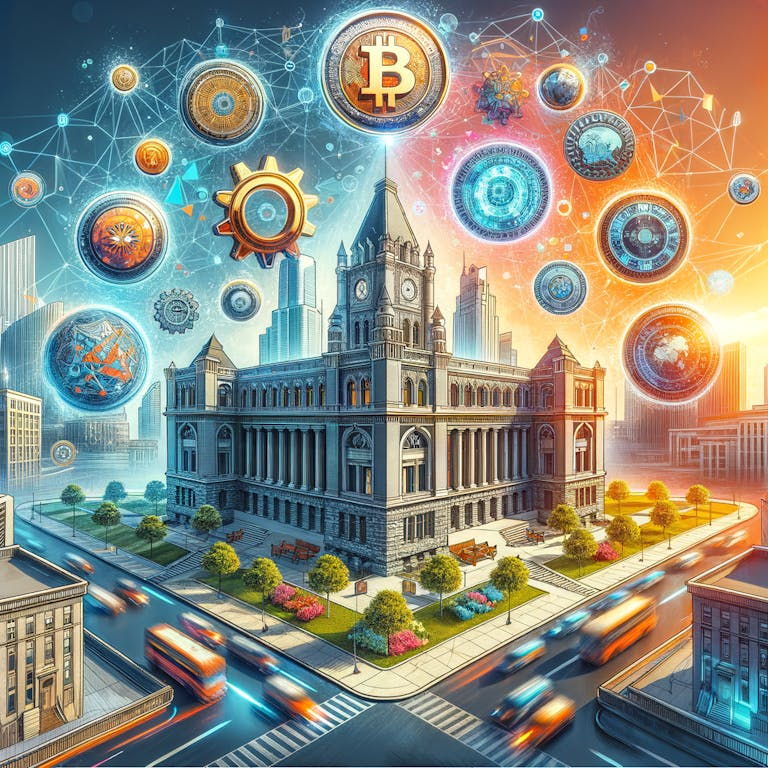From Centralization to Decentralization: Unveiling the Revolutionary Potential of Blockchain in Web 3.0
Web 3.0, where blockchain technology is at the forefront of a revolution. In this article, we will explore how blockchain is transforming the traditional centralized model of the web into a decentralized and community-driven ecosystem.

Welcome to the future of the internet - Web 3.0, where blockchain technology is at the forefront of a revolution. In this article, we will explore how blockchain is transforming the traditional centralized model of the web into a decentralized and community-driven ecosystem.
The Evolution of the Web
Before we dive into the potential of blockchain in Web 3.0, let's take a quick look at the evolution of the web. Web 1.0 was the early days of the internet, where static websites provided information but lacked interactivity. Web 2.0 brought about a new era of user-generated content, social media, and online collaboration. However, both Web 1.0 and Web 2.0 were built on a centralized model, where power and control were in the hands of a few.
The Power of Decentralization
Web 3.0, also known as the decentralized web, is set to disrupt this centralized model by leveraging blockchain technology. Blockchain, the underlying technology behind cryptocurrencies like Bitcoin, is a decentralized and transparent ledger that records transactions across multiple computers.
One of the key advantages of blockchain is its ability to eliminate the need for intermediaries. In a decentralized web, users can directly interact with each other, exchanging value and information without the need for a middleman. This peer-to-peer model not only reduces costs but also enhances security and privacy.
The Role of Blockchain in Web 3.0
Blockchain has the potential to revolutionize Web 3.0 in several ways. Firstly, it enables the creation of decentralized applications (dApps) that are not controlled by any single entity. These dApps run on a network of computers, ensuring that no single point of failure can disrupt their operation.
Secondly, blockchain allows for the creation of smart contracts, which are self-executing agreements with the terms of the contract directly written into code. Smart contracts eliminate the need for intermediaries and enable trustless transactions, as the terms are automatically enforced by the blockchain.
Furthermore, blockchain technology enables the creation of digital identities and reputation systems that are owned and controlled by individuals. This puts users back in control of their personal data and provides them with the ability to manage their online identities more securely.
The Community-Driven Web 3.0
One of the most exciting aspects of Web 3.0 is its emphasis on community-driven governance. In a decentralized web, decisions are made collectively by the community, rather than by a centralized authority. This allows for a more inclusive and democratic internet, where users have a say in the development and governance of the platforms they use.
Blockchain-based platforms are already emerging that empower users to participate in decision-making through voting mechanisms and token-based economies. These platforms aim to create a more equitable and transparent internet, where the power is distributed among the community.
The rise of Web 3.0 and blockchain technology is transforming the internet from a centralized model to a decentralized and community-driven ecosystem. Blockchain enables the creation of decentralized applications, smart contracts, and digital identities, while empowering users to participate in decision-making and governance. With its revolutionary potential, blockchain is set to redefine the future of the internet in Web 3.0.
The Challenges and Opportunities of Blockchain in Web 3.0
While blockchain technology has the potential to revolutionize the web, it also comes with its own set of challenges. One of the main challenges is scalability. As more users join the network and the number of transactions increases, blockchain networks can become slow and inefficient. This is a problem that needs to be addressed in order to ensure the widespread adoption of blockchain in Web 3.0.
Another challenge is the issue of interoperability. Currently, there are multiple blockchain networks, each with its own set of rules and protocols. In order for Web 3.0 to become a reality, these networks need to be able to communicate and interact with each other seamlessly. Interoperability standards and protocols are being developed to address this challenge and enable the exchange of value and information across different blockchain networks.
Despite these challenges, there are also numerous opportunities that come with the adoption of blockchain in Web 3.0. One of the biggest opportunities is the democratization of finance. Blockchain technology has the potential to eliminate the barriers to entry in the financial industry, allowing anyone with an internet connection to access financial services and participate in the global economy.
Blockchain also has the potential to revolutionize supply chain management. By providing a transparent and immutable record of every transaction along the supply chain, blockchain can enhance traceability, reduce fraud, and improve efficiency. This can have a significant impact on industries such as logistics, retail, and agriculture.
Furthermore, blockchain technology can enable new business models and revenue streams. With the ability to create and manage digital assets on the blockchain, content creators can directly monetize their work without the need for intermediaries. This can empower artists, musicians, and other creators to take control of their intellectual property and earn a fair income.
The Future of Web 3.0
As blockchain technology continues to evolve, we can expect to see further advancements in Web 3.0. One area of development is the integration of artificial intelligence (AI) with blockchain. AI can analyze the vast amount of data stored on the blockchain, identify patterns, and make predictions, leading to more intelligent and personalized services.
Another area of development is the integration of Internet of Things (IoT) devices with blockchain. By connecting IoT devices to the blockchain, we can create a secure and decentralized network of devices that can autonomously interact and transact with each other. This has the potential to revolutionize industries such as healthcare, energy, and transportation.
Conclusion
Blockchain technology is transforming the web from a centralized model to a decentralized and community-driven ecosystem in Web 3.0. While there are challenges to overcome, such as scalability and interoperability, there are also numerous opportunities in finance, supply chain management, and content monetization. As blockchain technology continues to evolve and integrate with AI and IoT, we can expect to see further advancements in Web 3.0 that will revolutionize industries and empower individuals.
Socials
- Website : https://lamedusegroup.com
- LinkedIn : https://www.linkedin.com/company/lameduse
- Twitter : https://twitter.com/lamedusegroup

